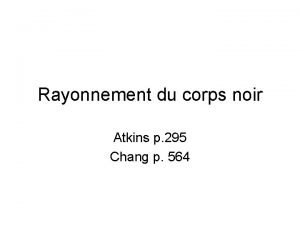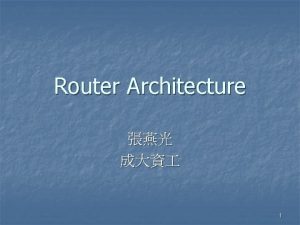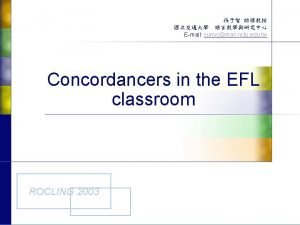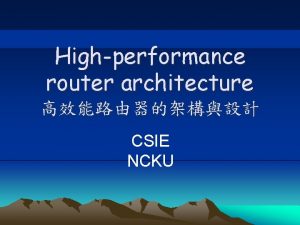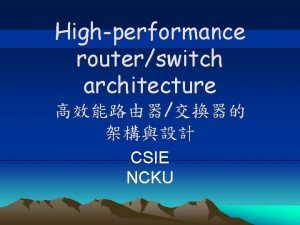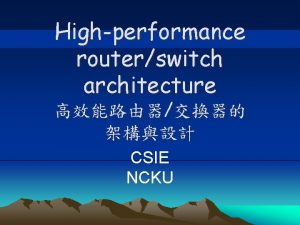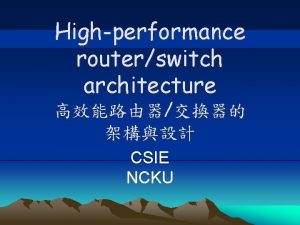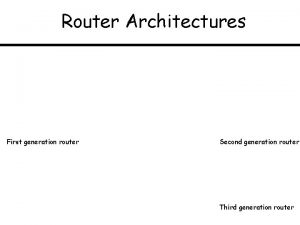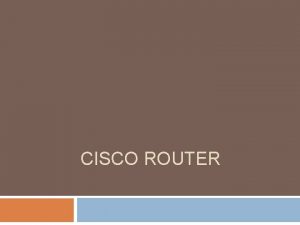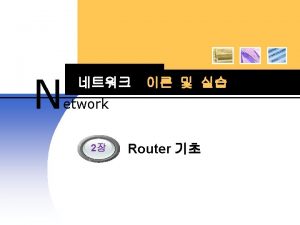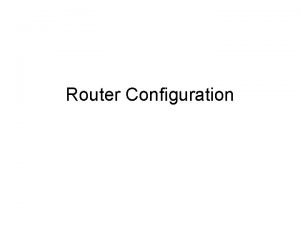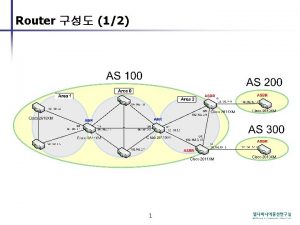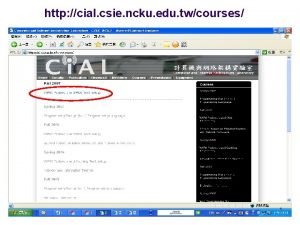Highperformance router architecture CSIE NCKU Focus In todays













- Slides: 13

High-performance router architecture 高效能路由器的架構與設計 CSIE NCKU

Focus • In today’s era of high-speed Internet, explosive traffic growth requires the support of high-performance routers. High -performance router design is an important and interesting research topic. We will introduce the algorithms that are commonly used in packet processing needed in the routers. We also describe router architectures and the challenges involved in designing high-performance large-scale router. The course will give the research topics for the area. 2

Content • • Introduction Router History Router architecture IP Lookup TCAM Packet Classification Network Processors 3

Textbooks • Deepankar Medhi & Karthikeyan Ramasamy, Network Routing Algorithms, Protocols, and Architectures, Morgan Kaufmann, 2007. (ebook in NCKY library) • George Varghese, Network Algorithmics: An Interdisciplinary Approach to Designing Fast Networked Devices, Morgan Kaufmann, 2005. (hardcopy in NCKY library) • H. Jonathan Chao, Bin Liu, High performance switches and routers, John Wiley and Sons Ltd, 2007. (hardcopy in NCKY library) 4

IP Lookup • Other terminologies: – – – – IP address lookup, IP forwarding, routing table lookups, longest prefix match (LPM), IP packet processing, 1 -dimensiional packet classification Forwarding table (line card) and Routing table Currently, 300 -400 K prefixes in a core router 5

IP Lookup • Research directions: – – – – Search speed Update speed Memory requirement Ability to handle large routing tables Flexibility in implementation Low preprocessing time Software and hardware based (TCAM, FPGA) IPv 6 6

IP Lookup • M. A. Ruiz-Sanchez, E. W. Biersack, and W. Dabbous, “Survey and taxonomy of IP address lookup algorithms, ” IEEE Network, vol. 15, pp. 8– 23, March 2001. • Schemes for optimizing search speed – – – Multibit tries Two-level multibit trie, 16 -16, 24 -8 Binary range search (endpoint) Binary search on prefix length Binary prefix search Binomial Spanning tries based on Hamming and Golay perfect codes – FPGA pipelined implementation (over 100 Gbps) 7

IP Lookup • Schemes for optimizing memory requirement – Small forwarding table (SFT): compressed 16 -8 -8 trie – Level compressed (LC) trie – Huang ‘s compressed 16 -x (C-16 -x) – Compressed 8 -8 -8 -8 trie using minimal perfect hashing function – Hierarchical endpiont tree (01** 0100 and 1000) – Tree bitmap (compressed 4 -4 -4 -4 -4 trie) – Memory optimized multibit tries with dynamic programming 8

IP Lookup • Schemes for optimizing update speed (log N) Binary – – – Binary tree on binary tree scheme (PBOB), Priority search tree scheme (PST), Collection of red-black tree schemes (CRBT) Most Specific Prefix Tree (MSPT) Multigroup Most Specific Prefix Tree (MG-MSPT) Dynamic segment tree (DST), extending binary range search Multiway – Multiway range tree (MRT) – Prefix in B-Tree (PIBT) – Dynamic Multiway Segment Tree (DMST) 9

Packet Classification • Multi-dimensional packet classification – Normally five fields: source IP, source port, destination IP, destination port, protocol number – source/dest IP fields are in prefix format (32 -bit) – source/dest port fields are in range format (16 bit) – protocol number field is in format of exact value (8 -bit) • Rule tables – 10 k rules – Firewall, IP Chain, and Acess Control List (ACL) 10

David Taylor’s Survey (Before 2003) Exhaustive Search Decomposition Crossproducting TCAM RFC ABV Linear Search EGT Hi. Cuts Grid-of-Tries Decision Tree FIS Trees E-TCAM Pruned Tuple Space Rectangle Search Tuple Space 11

Packet Classification • David E. Taylor, Survey & Taxonomy of Packet Classification Techniques, ACM Computing Surveys, Volume 37, Issue 3, 238 -275, September 2005. • Hierarchical trie, set-prunning trie, grid of trie • Hierarchical binary search structures • Hierarchical, set-prunning, grid of segment tree • 2 -phase schemes, 5 independent 1 -D search+merge – Lucent Bit vector – Cross-product + Bloom Filter – TCAM range encoding • FPGA pipelined implementation (over 50 Gbps) – USC Prashana’s group 12

Packet Classification • Hardware (ASIC and FPGA) are usually adopted because of extremely high classification rate, but difficult to upgrade to other platforms to support new applications or consume too much electric power and board area for large classifiers • TCAM: Ternary Content Addressable Memory • Network processor is a programmable processor designed for network applications with the advantages of high performance of ASIC and the programming flexibility. • SRAM: Algorithm + Data structure 13


